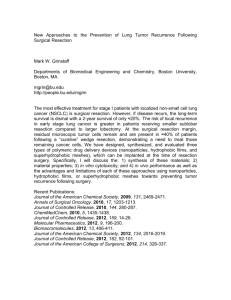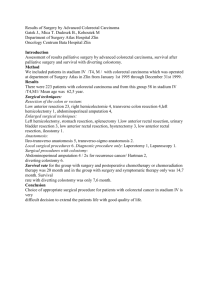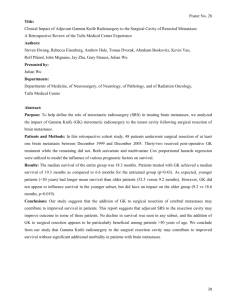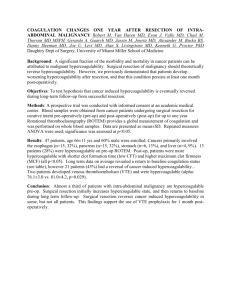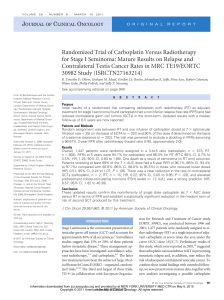optimal
advertisement
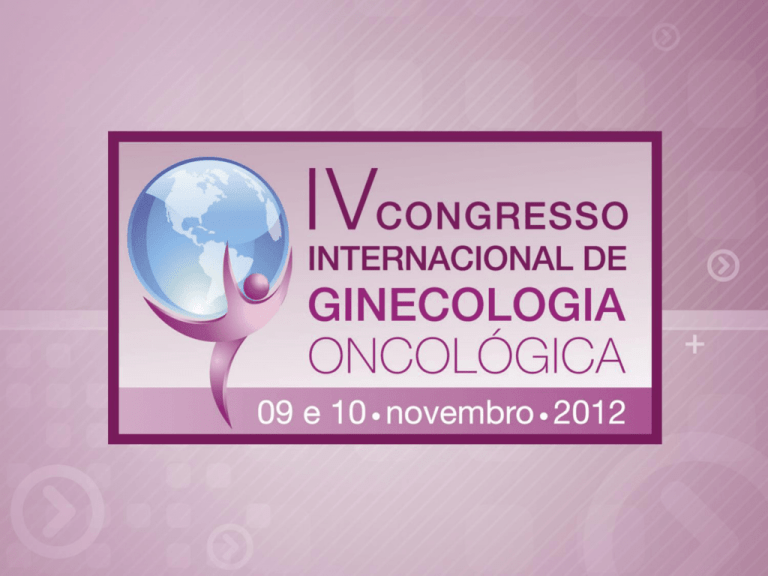
Clique para editar o título mestre Resection Criteria: Advance Ovarian Cancer Robert L. Coleman, M.D. Professor & Vice Chair, Clinical Research Department of Gynecologic Oncology M.D. Anderson Cancer Center What is Really Being Asked? • What are the surgical goals? • What is the evidence that achieving these goals will translate into better outcomes for patients? • Can aggressive surgery overcome innate biology? • Can we predict in whom heroic surgical effort should be undertaken? • Options? See the coming debate… Surgical Management of Primary Ovarian Cancer • Theoretical: – Reduced the volume of hypoxic, poorly perfused cells – Host immunocompetence is improved with lower tumor burden – Recruitment of residual cells into G1 potentiating the effects of cytotoxic therapy – Removal of chemoresistant clones • Practical: – “Biology vs Brawn” The Case to Operate Griffiths, Natl Cancer Inst Monogr 42:101, 1975 Survival By Cytoreduction Outcome Griffiths, Natl Cancer Inst Monogr 42:101, 1975 Primary Cytoreduction Meta-analysis: 53 studies (1989-98) – 81 cohorts (Stage III/IV) – N = 6885 patients Results – Expert centers have high optimal rates – Optimal vs. not: 11 mos (50% increase) – Each 10% in cytoreduction = 5.5% in survival – Platinum intensity = NS 42 100 40 90 38 80 36 70 34 60 32 50 30 40 28 30 26 24 20 22 10 20 0 0 10 20 30 40 50 60 70 80 90 100 Bristow, J Clin Oncol 20:1248, 2002 Aggressive Cytoreduction: What’s Optimal? • N = 408, Stage IIIC patients • “Ranked” (Likert 0-3) – RUQ, LUQ, Pelvis – Retroperitoneum, Central Abdomen No Residual Residual: 1-10 mm Residual > 10 mm Eisenkop Gynecol Oncol 90:390, 2003 Survival Data based on Primary Surgical Intent “Optimal” “Suboptimal” Chi Gynecol Oncol (2006) 103:559-64 The Impact of Residual Tumor: What Is Optimal Debulking? % Progression-free Survival 100% 75% HR 50% 0 mm 25% (95%CI) 1-10 mm vs. 0 mm: 2.52 (2.26;2.81) >10 mm vs. 1-10 mm: 1.36 (1.24;1.50) log-rank: p < 0.0001 1-10 mm > 10 mm 0% 0 12 24 36 48 60 72 84 96 108 120 132 144 Generated from 3 prospective Phase III trials (OVAR 3,5, & 7) N = 3126 pts 100% % Overall Survival 75% HR 0 mm 50% 25% 1-10 mm 24 36 48 60 72 84 96 108 120 132 2.70 (2.37; 3.07) >10 mm vs. 1-10 mm: 1.34 (1.21; 1.49) DuBois, Cancer (2009)115:1234 0% 12 1-10 mm vs. 0 mm: log-rank: p < 0.0001 > 10 mm 0 (95%CI) 144 Can Surgery Overcome Biology? Presented with “Optimal Disease (≤ 1cm) Was debulked to “Optimal Disease (≤ 1 cm) Hoskins, Gynecol Oncol 1992; 47:159 Advanced stage ovarian cancer – Does complex surgery improve survival? An analysis of GOG 182 Bunja Rungruang, MD Magee-Womens Hospital of UPMC Primary Therapy: GOG-0182 FIGO III-IV All residuum EOC or PPC International Paclitaxel 175 mg/m2 3-hour Carboplatin AUC 6 mg/ml.min All regimens = 8 cycles Interval cytoreduction allowed NO Second Look surgery Paclitaxel 175 mg/m2 3 -hour Carboplatin AUC 5 mg/ml.min Gemcitabine 800 mg/m2 day 1,8 End Points: PFI, Survival, Response N = 4312 (4135 evaluable) Paclitaxel 175 3-hour ALTERNATE Carboplatin AUC 5 mg/ml.min Paclitaxel 175 mg/m2 3 -hour Carboplatin AUC 5 mg/ml.min PLD 30 mg/m2 Topotecan 1.5 mg/m2 Day 1-3 Carboplatin AUC 5 mg/ml.min Paclitaxel 175 mg/m2 3-hour Carboplatin AUC 6 mg/ml.min mg/m2 Gemcitabine 1000 mg/m2 day 1,8 Carboplatin AUC 6 mg/ml.min THEN THEN Paclitaxel 175 mg/m2 3-hour Carboplatin AUC 6 mg/ml.min GOG 182-ICON5: Endpoints PFS OS Bookman, J Clin Oncol (2009), 27:1419-25 Microscopic residual has better OS Overall Survival Rate Microscopic n=860 (median 77 mo) Macroscopic n=1 795 (median 41 mo) Microscopic Macroscopic (<1cm) Logrank p<0.0001 Time at risk (months) Disease Burden Score (DS) Group Pelvic and retroperitoneal Abdominal DS-low X DS-moderate (DS-mod) X X DS-high X X Upper abdominal X Surgical Complexity Score (CS) Procedure Points TH-BSO 1 Omentectomy 1 Pelvic lymphadenectomy 1 Paraaortic lymphadenectomy 1 Pelvic peritoneum stripping 1 Abdominal peritoneum stripping 1 Small bowel resection(s) 1 Large bowel resection 2 Diaphragm stripping/resection 2 Splenectomy 2 Liver resection(s) 2 Rectosigmoidectomy with anastomosis 3 Group Surgical Complexity Score CS-low 1-3 CS-moderate (CS-mod) 4-7 CS-high >8 Aletti, et al. Am J Obstet Gynecol 2007. Biology of Disease vs. Effort Analysis of GOG 182 Micro+CS-highn=81 (46.1 mos) DS-mod group n=846 (med: 71 mos) <1cm+CS-low n=226 (39.4 mos) DS-high group n=1636 (med:40 mos) <1cm+CS-mod n=925 (39.3 Overall Survival Rate DS-low group n=173 (med: 86 mos) mos) <1cm+CS-high n=286(40.4 mos) DS-low <1cm + DS-high + CS-mod <1cm + DS-high + CS-high Logrank p<0.0001 All with R0 disease Time at risk (months) All Optimal (R0 or R<1cm) Logrank p=0.1830 Time at risk (months) All DS-High (12% with R0) Rungruang, SGO 2012 Paradigm shift for high disease burden • Extensive disease Primary complete resection microscopically debulked in only 12% • Surgical gains are achieved though Neoadjuvant chemotherapy cytoreduction to with interval complete resection microscopic residual • Efforts to better define candidates for complete Primary surgery with gross residual disease resection Central Question… “One of the important questions is how to select patients for primary debulking or interval debulking with the aim of leaving no residual tumor at the time of surgery.” Vergote I. Gynecol Oncol 2010; 119: 1. Selection of Surgical Candidates • Easy to assess: – Medically unfit/unstable • High intraoperative surgical risk (cardiovascular, pulmonary, etc) • High postoperative healing risk (uncontrolled DM, steroid dependency, etc) • Harder to assess: – Heavy disease burden not amenable to resection • Hepatic, portal, extra-abdominal disease – Heavy disease burden not amenable to optimal resection • Upper abdomen, diaphragm, pleural Predicting Suboptimal Resection ● CA125 - >500 U/ml common threshold - False positive in 22% to 31% of cases ● Imaging (CT/MRI) - Multiple criteria proposed - False positive in 12% to 33% of cases ● Diagnostic surgery - laparoscopy to assess resectability Predicting Suboptimal Resection Problem: External Validity Axtell, J Clin Oncol 2007 Cytoreduction and Biology • RNA 44 patients (19 optimal, 25 suboptimal) • Affymetrix chip (22,283) – Top 120 genes used in model – MAP2K4 & MAP3K7 (metastases suppressing genes) • Predictive accuracy: 72.7% – CA-125 > 500: 75% accuracy (Berek, Gyn Onc, 2000) Berchuck, Am J Obstet Gynecol 190:910, 2004 Cause Célèbre Management Options Presumed Advanced Ovarian Cancer I. Primary Cytoreduction (Extensive if Needed) II. Limited Primary Cytoreduction Interval Cytoreduction III. Neoadjuvant Chemotherapy Followed by Cytoreduction Neoadjuvant Chemotherapy in Ovarian Cancer 9/21/10 1/20/11 NACT: Interpretation • Powerful effect of selection bias – Sicker patients get NACT – Responding patients get surgery – Surgical effort different in primary vs NACT patients within and between individual centers • No standards on appropriate therapy before surgical consideration Primary Approach: What’s Best? N Engl J Med (2010) 363:943 Thank You!
